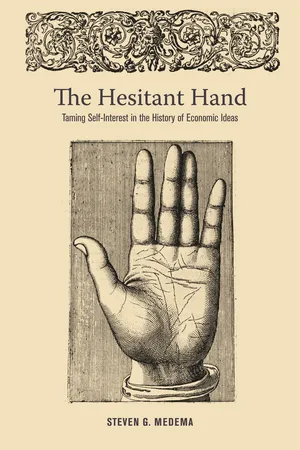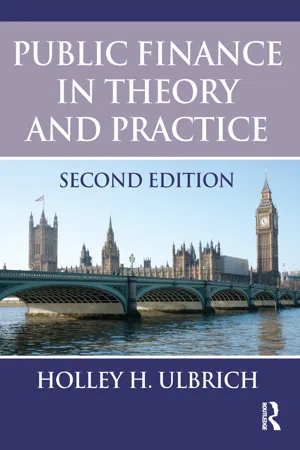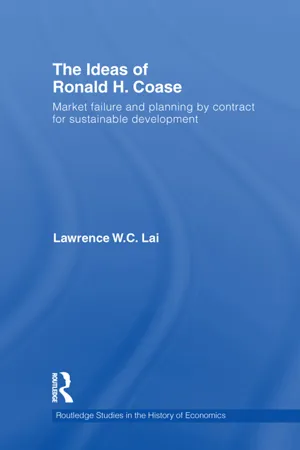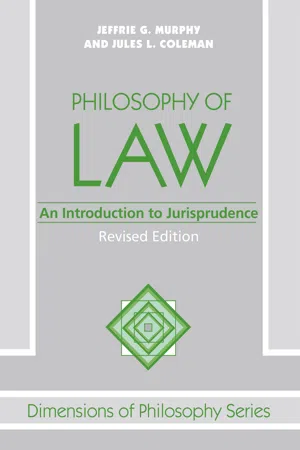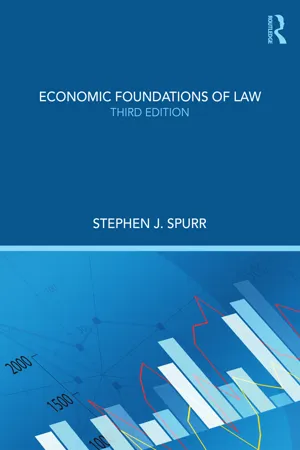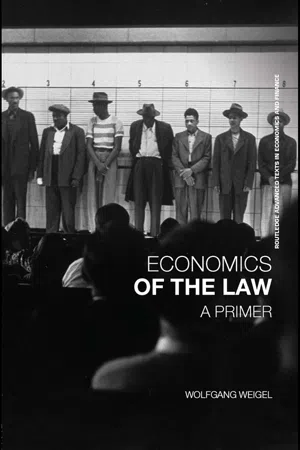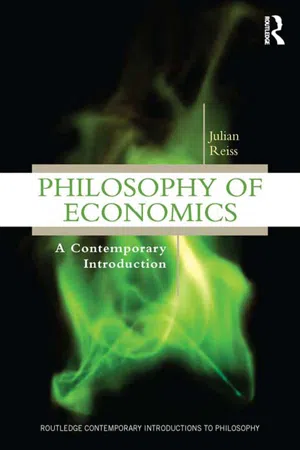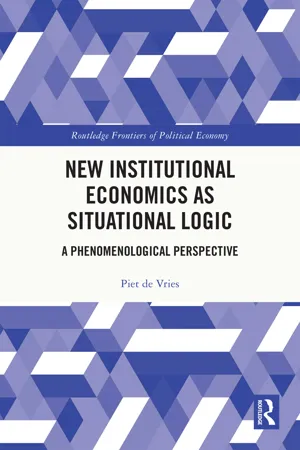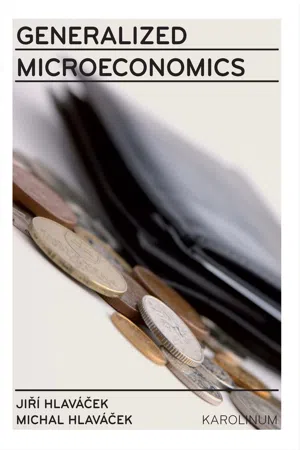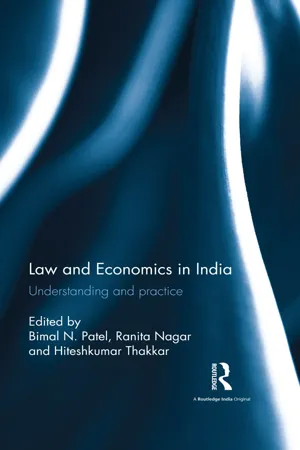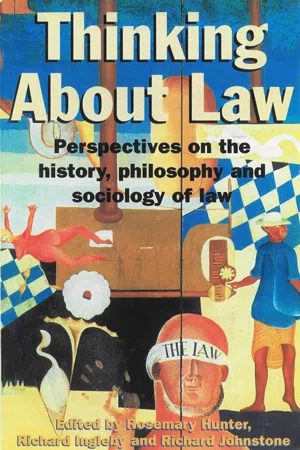Economics
Coase Theorem
The Coase Theorem states that in the presence of well-defined property rights and in the absence of transaction costs, parties will negotiate to reach an efficient outcome regardless of the initial allocation of property rights. This means that if property rights are clearly defined and transaction costs are low, private bargaining can lead to an efficient allocation of resources.
Written by Perlego with AI-assistance
Related key terms
Related key terms
1 of 4
Related key terms
1 of 3
11 Key excerpts on "Coase Theorem"
- eBook - ePub
The Hesitant Hand
Taming Self-Interest in the History of Economic Ideas
- Steven G. Medema(Author)
- 2009(Publication Date)
- Princeton University Press(Publisher)
it is necessary to know whether the damaging business is liable or not for damage caused since without the establishment of this initial delimitation of rights there can be no market transactions to transfer and recombine them. But the ultimate result (which maximizes the value of production) is independent of the legal position if the pricing system is assumed to work without cost. (Coase 1960: 8)The Coase Theorem has been stated in several different ways, often with slight, but not necessarily unimportant, variations. Two of the classics are George Stigler’s (1966: 113) statement that “under perfect competition private and social costs will be equal”—the first naming of the Coase Theorem in print—and A. Mitchell Polinsky’s (1974: 1665) assertion that “[i]f transaction costs are zero, the structure of the law does not matter because efficiency will result in any case.”44 A statement that closely follows the spirit of Coase can be worded this way: If rights are fully specified and transaction costs are zero, parties to a dispute will bargain to an efficient and invariant outcome regardless of the initial specification of legal rights. This statement of the theorem contains two explicit assumptions and two assertions regarding the results.Let us begin with the results, which can best be understood as two theses regarding outcomes. The first is the efficiency thesis , which states that the outcome of the bargaining process will be efficient, regardless of who is initially assigned the right. The concept of efficiency underlying the Coase Theorem is Paretian—the exhaustion of all potential gains from trade45 —and much of the recent analysis by economists attempting to assess the validity of the theorem employs the Paretian notion of efficiency. Coase himself used the concept of efficiency in multiple ways in his analysis (maximizing the value of production and minimizing costs, in particular), while, within contemporary economic analysis of law, wealth maximization and cost minimization are the most frequently employed variants of the efficiency concept. The second of the implied results is the invariance thesis: The outcome of the bargaining process—the allocation of rights and resources (although not necessarily the distribution of income)—will be the same , regardless of who is initially assigned the right. That is, while the efficiency thesis contends that the final allocation of resources consequent to any particular assignment of rights will lie on the contract curve, the invariance thesis says that the final allocation will lie on the same point - Holley Ulbrich(Author)
- 2013(Publication Date)
- Routledge(Publisher)
In recent decades, much attention has been given to identifying existing mechanisms for correcting externalities as well as devising new techniques. They include:- assignment of property rights (the Coase Theorem);
- tax incentives and vouchers;
- educational/informational programs to encourage or discourage certain types of production;
- the development of markets in permits for emissions;
- shifting production to a lower level of government or a nonprofit provider.
The Coase Theorem, developed by Nobel prize winner Ronald Coase, suggests that some externality problems could be resolved through assignment of property rights. Specifically, this theorem says that, where small numbers of participants are involved, property rights can be assigned to one of the parties for a contested resource (such as the use of a lake or waterway), and subsequent negotiations will result in the socially optimal use of the resource. This outcome is independent of which of the two parties is given the property right, although the distributional effects can be an important consideration (Coase 1960).For example, suppose that an industrial firm and a group of nature lovers are interested in using a small lake, the former for discharging wastes, the latter for swimming, boating, and fishing. These two uses are not compatible. Which is the best and highest use of the lake? If it is assumed that both parties have enough resources to express their effective demand, then the lake should be used by the party who is willing to pay the highest price for the use of the lake. Suppose that the industrial firm is assigned the right to use the lake as it sees fit. The group of nature lovers could make the firm an offer to restrict its effluent below a certain level that would make the lake still usable for recreation. If the cost of disposing of its effluent in another way was less than the amount offered by the nature lovers, the industrial firm would agree, and the lake would be used for fishing, boating, and swimming.- eBook - ePub
The Ideas of Ronald H. Coase
Market failure and planning by contract for sustainable development
- Lawrence W. C Lai(Author)
- 2011(Publication Date)
- Routledge(Publisher)
Part II , this work is an original attempt to outline a much-wanted research project by (a) examining the inner logic of the theorem; (b) deriving propositions on the basis of the mischief of the theorem – that is, to deal with positive transaction costs in reality; and (c) taking stock and interpreting existing planning works that touch on Coasian transaction cost concepts, giving an example of how the derived propositions can be applied to organise empirically refutable planning research hypotheses.6.2 The internal logic of the Coase Theorem
The Coase Theorem is often mistaken to be the same as libertarian economics in which no role for town planning is allowed. That is neither the intention of Coase nor the logic of the Coase Theorem, as particularly explained in Chapters 1 and 3 and the such works as Webster and Lai (2003). The Coase Theorem, if properly understood, is indeed extremely versatile and fruitful for planning policy and research.The actual formulation of the Coase Theorem, to recall our discussions in Chapters 2 and 3 , was deduced by Nobel laureate George J. Stigler (1966, 1987) from fellow laureate Coase’s paper ‘The Problem of Social Cost’ (1960), which was an article written with a view to rejecting Pigou’s (1932) concept of externality as a reason for state intervention in the market.Stigler’s formulation had two variants, which may be described as the ‘invariant theorem’ and the ‘optimality theorem’ (Cheung 1990). The invariant theorem reads: ‘given zero transaction cost and clearly defined property rights, the assignment of rights and liabilities would not affect resource allocation.’ In other words, ‘given zero transaction cost and clearly defined property rights, resource allocation would be identical irrespective of (and thus ‘invariant’ to) the pattern of rights and liabilities, or the way in which they are assigned.’2 - eBook - ePub
Philosophy Of Law
An Introduction To Jurisprudence
- Jeffrie G. Murphy(Author)
- 2018(Publication Date)
- Routledge(Publisher)
Finally, one might respond that strategic behavior is a failure to cooperate. Cooperation is a background condition of the Coase Theorem. Strategic behavior is therefore ruled out by the assumption that the parties cooperate with one another. In this view, cooperation entails the success of negotiations: cooperation entails agreement. This, too, is an odd use of the term “cooperate.” We would normally distinguish cooperating from noncooperating parties by their willingness to negotiate, not by the success of their negotiations. There is no contradiction involved in the report that two parties came to the bargaining table, tried to iron out their differences, fully cooperated with one another, but were unable to reach an accord, thereby forcing the matter to arbitration.On the other hand, we could define cooperation so that it would entail successful bargaining. But then the Coase Theorem would be an even less informative proposition than it is normally taken to be. For the claim that when transactions are costless and parties cooperate market exchanges circumvent inefficient rules just means that when transactions are costless agreement is necessary. Private exchange can only fail to be efficient if agreement is not reached. Agreement is not reached only if parties are unable to agree on a division of the stakes, or if transaction costs make negotiations unprofitable. If transaction costs make negotiations unprofitable, no effort at exchange is made. But when transaction costs are low, our experience is that rational people still sometimes fail to reach agreement. But if we ascribe all such failures to a breakdown in cooperation, then we have simply trivialized the theorem, for we have identified all the conditions that could ever lead to its falsifiability and have assumed their absence in the statement of the theorem’s initial conditions. Understood this way, Coase does not offer an alternative approach to externalities. The Coase Theorem is simply a stipulative definition of rational cooperation in the absence of transaction costs.35Posner, Efficiency, and Utility
Because so much emphasis has been placed on the zero transaction cost condition of the Coase Theorem, the central question in the law and economics literature has been, “What should a court (or legislature) do when transaction costs are high?” The general principal, first advanced by Posner, is that law should “mimic the market,” that is, replicate the outcome of costless exchange. In the case of assigning property rights, mimicking the market means allocating rights or resources to those individuals who would have purchased them in the costless exchange market. - eBook - ePub
- Stephen J. Spurr(Author)
- 2019(Publication Date)
- Routledge(Publisher)
How then do we decide whether the entitlement should be protected by a property right, a rule of liability, or by direct government intervention? In making this decision, we should consider what has come to be known as the Coase Theorem (Coase 1960). According to the Coase Theorem, if there are no transaction costs and property rights are well defined, the parties will agree on a Pareto-optimal, efficient outcome. They will arrive at an efficient outcome regardless of the way property rights are assigned. The implication is that if transaction costs are zero or relatively small, entitlements should be protected by property rights. Regardless of who has the property right – the entitlement – the parties will arrive at an efficient outcome.The Coase Theorem can be understood as a response to classical welfare economics, the most prominent representative of which was A. C. Pigou (1877–1959). This area of economics considered problems involving externalities. An externality arises when the actions of one economic agent affect the environment of another in some way other than a change in prices. Important examples of externalities are pollution and congestion.Consider, for example, the conflicting interests of a cattle rancher and a farmer who have adjacent properties. The larger the herd of cattle raised by the rancher, the more the farmer’s crops will be trampled by cattle who wander away from the ranch (assume there is no fence because both properties are very large, and the costs of building and maintaining a fence would exceed the benefits). This situation is illustrated in Figure 4.1 . MCp represents the private marginal cost of raising cattle to the rancher, and P* represents the market price of beef. If the cattle rancher disregards the damage caused by his cattle, he will raise Qp cattle, since at this level of output he is maximizing profits; at Qp his price = marginal revenue = marginal cost.10 However, this outcome is not efficient, since it ignores an externality – the damage to the farmer’s crops.To achieve efficiency, we must maximize total social benefit minus total social cost. We can do this by setting the size of the herd at the level where the marginal social benefit of cattle equals its marginal social cost. Note that the marginal social benefit equals the market price of beef, since this price – the height of the market demand curve at equilibrium – represents the value of an additional steer to society. MCs represents the marginal social cost of cattle, which increases with the number of cattle. The vertical distance between MCp and MCs equals the damage to the farm, a cost not borne by the rancher. The socially optimal level of cattle production is Qs - eBook - ePub
Economics of the Law
A Primer
- Wolfgang Weigel(Author)
- 2013(Publication Date)
- Routledge(Publisher)
The discussion about the Coase Theorem is almost unmanageable. To illustrate, the entry ‘externalities and the Coase Theorem’ in the Bibliography of Law and Economics contains 140 contributions. Therefore, an exhaustive appreciation is an impossible task. While there was (and still is) much praise for Ronald Coase culminating in the opinion that he initiated the emergence of a new paradigm there has always also been fierce criticism. Let us conclude the presentation with three examples of objections.First, does the theorem neglect important insights from microeconomic theory? The argument runs as follows: according to the theorem, the allocation emerging from bargaining is independent of the initial assignment of property rights. However, in the case of a negative externality between neighbouring households the negotiation cannot be independent of purchasing power. Thus the preferences of either side can be effectuated better the higher the initial endowment with purchasing power, which will be reflected in the willingness to pay or the claim for compensation. Consequently, it is true that the results of bargaining are efficient, but the results will vary according to difference in initial conditions!Second, the theorem is logically flawed! This argument runs as follows. The logic of the theorem is the following: in a case transaction costs are zero (A), it follows that the initial assignment of property rights does not affect the efficiency in resource allocation (B). So the logic is ‘B follows from A’. But B can have two different meanings here, that is to say (1) every assignment of property rights gives rise to an efficient allocation of resources, where efficiency requires some initial assignment of property rights and (2) resources are admitted to efficient use independently of some assignment of property rights. But only either (1) or (2) can hold, so there is an inherent logical contradiction contained in Coase’s analysis. Although his findings contain much truth, they cannot obtain as a ‘theorem’. - eBook - ePub
Philosophy of Economics
A Contemporary Introduction
- Julian Reiss(Author)
- 2013(Publication Date)
- Routledge(Publisher)
Now suppose that the “polluter” is not facing one “victim” but many. The “polluter” might be a company using a dirty industry and the “victims” the entire population of the region affected by by-products of the production process. Given the affected population is large, it is likely that the most efficient solution requires the firm to install emission controls. But if the firm has the right to pollute, the individuals living in the affected area face a collective-action problem analogous to contributing to a public good. Everyone has an incentive to free ride, and it is unlikely that the public good—clean air in this case—will be produced. The converse is true when people in the region have the right to live pollution-free. The firm could offer compensation, but since each individual has a veto right, everyone has an incentive to use his or her bargaining power to extract more money and negotiations will break down.Coase regards these adverse incentive structures as creating transaction costs. In the absence of transaction costs, efficient solutions can be found, and the allocation of property rights does not matter. With transaction costs, the free market is unlikely to supply efficient solutions, and the allocation of property rights matters a great deal. In the last example, the firm using a dirty production process will produce an inefficiently high amount of pollution unless the affected individuals are able to solve the collective-action problem if it has the right to pollute; if people have the right to clean air, an inefficiently low amount of pollution will be produced.The discussion of the Coase Theorem nicely illustrates how different kinds of market imperfections interrelate. More importantly, it makes plain that it is not normally possible to ignore moral considerations when one thinks about how best to organize or regulate production processes. In the next subsection I will look at some of the relevant considerations.The Moral Limits of Coase's Theorem
Coase's essay is titled “The Problem of Social Cost.” Let us focus on the idealized case in which there are no transaction costs first. The “social costs” Coase considers are measured exclusively in terms of efficiency. As we saw in the previous chapter, an allocation is Pareto-efficient if and only if there is no alternative allocation that makes at least one individual better of without making at least one individual worse of. “Better of” and “worse of” are understood in terms of (actual) preference satisfaction. An individual is thus regarded to be better of in social state S' than in the status quo S if and only if that individual prefers S' to S - eBook - ePub
New Institutional Economics as Situational Logic
A Phenomenological Perspective
- Piet de Vries(Author)
- 2023(Publication Date)
- Routledge(Publisher)
The relevance of this type of distinction is that the latter offers opportunities to mitigate the divergence by a ‘modification of contractual relation between any two contracting partners’, for example, between a tenant and an owner (ibid.: 192). Regarding the former, Pigou recommends the ‘most obvious forms’ of state intervention, that is, ‘those of bounties and taxes’. In this instance, Pigou contends, the divergence arises outside the context of contracting partners (ibid.). Pigou’s qualification of his two types just misses the heart of the problem. He does not consider that a contractual flaw in one case against the lack of any contract in the other is just part of a common problem, that is, the hindrances to bargain appropriately about the divergence that harbors a potential of mutual advantages. On one hand, Pigou recognizes the opportunities for contractual modification. For the classic side effects, on the other hand, he does not recognize the contract opportunities. Therefore, he has recourse to the one-sided intervention of bounties and taxes, ‘from without’, that is, disregarding the individual. He lacks a concept: transaction cost. Transaction cost would align Pigou’s two divergence types.What is at issue is ‘to avoid the more serious harm’ (Coase 1959 : 26; 1960 : 2). As discussed, in such a case as the forester and the railway entrepreneur, they will conclude a Pareto-efficient bargain if the transaction cost is zero. If the train service is more valuable than foresting, the former is able to compensate the latter to refrain from his business. The market transaction results in maximizing the value of production. It means that all the parties involved in economic activity will contract with one another for the benefits and the losses the activity entails as their property rights are well defined and enforceable without cost. George Stigler (1972 : 11) phrases the bearing of the zero-transaction cost assumption as the Coase Theorem: ‘the manner in which legal rights were assigned would have no effect whatever upon the methods of production’.The world of a zero-transaction cost is a rather strange place, Stigler immediately adds (ibid.: 12). Furthermore, Coase (1988 - eBook - ePub
- Jirí Hlavácek, Michal Hlavácek(Authors)
- 2020(Publication Date)
- Karolinum Press, Charles University(Publisher)
94 is that of a doctor disturbed in his work by noise caused by the machinery of a confectioner in a neighbouring building. The traditional economic opinion was restrictive: the noise is harming the doctor, so the confectioner is obliged to eliminate the source of the noise. Coase noticed a seemingly obvious fact: eliminating the source of noise might help the doctor, but it will harm the confectioner. Either way, someone will always suffer damage. From the overall perspective it would clearly be better to implement the option involving less damage. Coase added that if we allow bargaining between the injured party and the “guilty party”, it is advantageous to both parties to implement the option involving the less serious harm.In other words, when the theorem’s assumptions are satisfied, negotiations between the parties will always lead to bargains that are advantageous to all the parties and simultaneously to optimal allocation of resources to environmental investments. Producers will, in their own interest in the given conditions, achieve what the state is trying in vain to achieve owing to a shortage of information. The negative externality will reach a level that is optimal from the point of view of society, for example from the point of view of a common owner of two factories.In the following section we will formulate the standard Coase Theorem for the most common case of a negative externality affecting two producers.9.2.1 THE Coase Theorem FOR NEGATIVE EXTERNALITIES: THE CASE OF TWO PRODUCERS
We solve the problem of two producers (a polluter and an injured party). We assume zero (negligible) costs associated with negotiating compensation. - eBook - ePub
Law and Economics in India
Understanding and practice
- Bimal N. Patel, Ranita Nagar, Hiteshkumar Thakkar, Bimal N. Patel, Ranita Nagar, Hiteshkumar Thakkar(Authors)
- 2016(Publication Date)
- Routledge India(Publisher)
However, there is an explanation for this belief, which has been given by economists. According to them, zero pollution can be achieved when there is zero production. It must be borne in mind that with any kind of manufacturing endeavour, there will be some resultant pollution. We as a society must decide what level of pollution we are willing to accept. The level of pollution can be reduced over the period of time with the help of better technologies and pollution-efficient inventions. 6 Figure 1.2 Supply curve with externalities (optimal pollution) Source: Author’s own compilation. Environmental costs: Coase Theorem Society’s concern with regard to defining, allocating and enforcing environmental property rights has led to the development of environmental law. It seems like an uphill task because of the dependence of environmental resources and its non-exclusivity and also because environmental elements are difficult to define and allocate. The legislatures and courts have tried to derive the most efficient model to protect the environment by applying several economic theorems. One of the most effective and popular is the interpretation of nuisance law with the help of the Coase Theorem. Nuisance law and the attempts of resolving conflicts between the police power of the state and the citizen’s right are difficult to internalize. The most desirable policy is lacking, and the courts and legislatures have been slow in making use of the cost–benefit analysis. The Coase Theorem was developed by Ronald Coase with regard to determining property rights. For the purposes of understanding the applicability of this theorem to environmental jurisprudence, the authors have proposed an example. Example: Consider a cement factory whose residue causes damage to about three residents whose houses are situated near the factory. If no corrective measures are taken, then each resident would suffer damages worth Rs 100 each, which would total Rs 300 - eBook - ePub
Thinking About Law
Perspectives on the history, philosophy and sociology of law
- Rosemary Hunter, Richard Ingleby, Richard Johnstone(Authors)
- 2020(Publication Date)
- Routledge(Publisher)
transaction costs the initial assignment of a property right will not affect the ultimate use of the property. Transaction costs include all the costs incidental to the transaction, such as the time and resources consumed in gaining information, identifying and getting together the other parties to a negotiation, and enforcing the bargain. Assuming transaction costs are zero, property rights will be transferred to those who value them the highest or, in opportunity cost terms, are prepared to pay the most for them.For example,22 assume that if a factory pollutes a river each of the five residential landowners downstream will suffer $500 damage. The pollution can be minimised by the factory owner spending $250 on filtering equipment or by each residential landowner purchasing a water purifier for $80 each. The Coase Theorem argues that it does not matter whether the relevant legal rule protects the residential landowner’s right to clean water or gives the factory owner licence to pollute. The most efficient solution is for the factory to install the filtering equipment—it is cheaper than the other solutions. If pollution is illegal, the factory will pay $250 for equipment rather than $500 damages to each of the landowners. If there is no rule outlawing pollution the landowners will club together to pay the factory $250, which is less than the total cost of each installing a water purifier. If, however, there are transaction costs of $60 for each residential landowner and the rule prohibits water pollution, the factory owner will still install the equipment for $250. But if the rule allows water pollution, it is cheaper for each landowner to purchase a water purifier, because of the transaction costs involved in their seeking to have the factory owner install the filtering equipment. Hence the transaction costs prevent the efficient solution being implemented irrespective of the legal rule. To achieve the efficient solution in a world of transaction costs the legal rule would need to prohibit pollution.23
Index pages curate the most relevant extracts from our library of academic textbooks. They’ve been created using an in-house natural language model (NLM), each adding context and meaning to key research topics.
Explore more topic indexes
Explore more topic indexes
1 of 6
Explore more topic indexes
1 of 4
